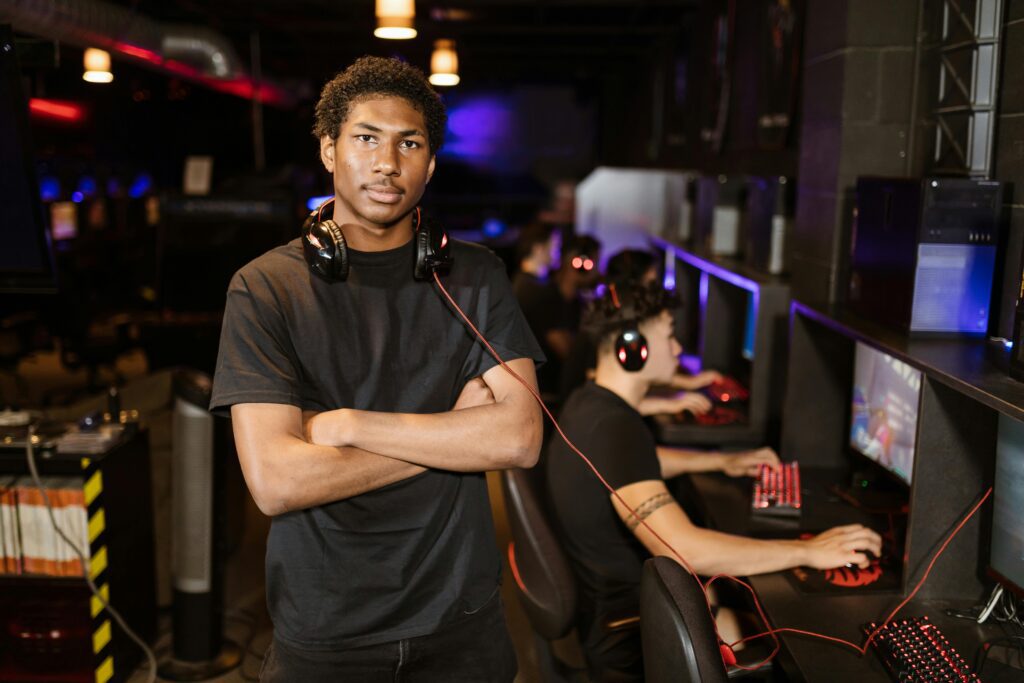The gaming industry is a global powerhouse, poised to generate $257 billion in revenue in 2028. Over 2.87 billion players worldwide immerse themselves in digital worlds, driving unprecedented demand for talented game designers.
This dynamic industry weaves together creativity, tech, and narrative, opening doors for those eager to craft interactive experiences. Still, breaking into game design now takes more than just a love for games.
The field favors those who pair bold ideas with a sense of duty, thriving in a world where innovation meets accountability. With gaming reshaping how people connect, the bar for aspiring designers is higher than ever.
Let’s find out more about building a career in game design.
Table of Contents
ToggleFoundations of a Game Design Career
Game design demands a wide range of skills. Storytelling creates compelling narratives, while coding in languages like C++ or Python builds interactive worlds. User experience (UX) design ensures gameplay feels intuitive, and psychology helps designers understand player motivations.
In 2023, the U.S. gaming industry supported 268,000 jobs, many requiring these skills. Formal education, such as degrees in game design or computer science, provides a strong start. Bootcamps provide quicker training, but practical experience sets candidates apart.
Internships at studios like Blizzard or Rockstar give aspiring designers real-world exposure. These roles teach collaboration and problem-solving under tight deadlines. Game jams, where teams build prototypes in days, sharpen creativity and teamwork.
A portfolio showcasing original games or mods demonstrates technical and artistic ability. Building these foundations through education, hands-on practice, and networking prepares designers for a competitive and fast-paced industry.
Navigating the Responsibility Side of Game Design
Games influence how players think and feel, reaching billions daily. In 2023, 73 percent of U.S. gamers said gaming strengthened their social connections, showing its cultural weight.
Yet, concerns about excessive screen time and addictive mechanics have grown. Features like loot boxes or time-locked rewards can keep players engaged for hours, raising questions about well-being. Designers must create experiences that entertain without encouraging unhealthy habits.
The industry has taken steps to address these issues. Major studios now include playtime reminders and transparent monetization policies. Trade organizations push for guidelines that prioritize player safety.
According to Forbes, gaming companies are increasing their attention to gaming safety and trust. Aspiring designers should study these trends to align with studios’ values. Balancing engagement with moderation is now a critical skill for building trust with players and employers.
Game Design and Ethical Issues
Game design faces increasing legal and public attention. Lawsuits targeting addictive game mechanics have sparked debates about designer accountability.
One prominent example, the Fortnite addiction lawsuit, claims Epic Games designed features that encourage compulsive play. These features often lead to addiction and financial exploitation of players.
TruLaw points out how such designs also push individuals psychologically, leading to behavioral and emotional issues. These lawsuits signal a need for designers to consider the real-world impact of their work.
Legal issues influence how studios operate. Designers must anticipate how mechanics like microtransactions could face criticism or litigation. Learning about gamer behavior and avoiding exploitative designs will help professionals navigate this landscape.
Ethical awareness is a core part of creating games that resonate responsibly.
What This Means for Your Career Path
Studios now prioritize ethics when hiring. Candidates who show technical skill and a commitment to player well-being stand out.
Portfolios that highlight balanced mechanics or fair monetization models demonstrate forward-thinking values. Attending events like the Game Developers Conference (GDC) allows designers to engage with industry leaders and stay updated on ethical trends.
Ongoing learning keeps designers competitive. Courses in player psychology or UX design certifications deepen expertise. Platforms like Steam, which saw 18,965 new game releases in 2024, offer insights into player feedback and preferences.
Designers who stay informed about legal and social shifts will lead the industry. A career in game design rewards those who blend creativity with a proactive approach to ethical challenges and player safety.
Shape the Future with Creativity and Care
The gaming industry brims with possibilities for new designers. This vibrant field merges imagination with technology, calling on innovators to create experiences that engage billions. However, success goes beyond designing captivating games.
Designers need strong technical abilities, a commitment to ethical standards, and the flexibility to navigate legal and social changes to succeed. Those who value player well-being while pushing creative boundaries will build enduring careers and reshape how the world enjoys games.
By blending artistic drive with a sense of responsibility, aspiring designers can guide the industry toward a future that honors its global community.
Game Designer's Salary
🇺🇸 United States
Entry-Level: $55,000 – $70,000 per year
Mid-Level (3–5 years): $75,000 – $95,000 per year
Senior-Level: $100,000 – $130,000+ per year
Top Companies (e.g., EA, Ubisoft, Riot Games): Up to $150,000+ per year
🇨🇦 Canada
Entry-Level: CAD 45,000 – CAD 60,000 per year
Mid-Level: CAD 65,000 – CAD 85,000
Senior-Level: CAD 90,000 – CAD 110,000+
🇬🇧 United Kingdom
Entry-Level: £22,000 – £30,000 per year
Mid-Level: £35,000 – £50,000
Senior-Level: £55,000 – £70,000+
🇦🇺 Australia
Entry-Level: AUD 50,000 – AUD 65,000
Mid-Level: AUD 70,000 – AUD 90,000
Senior-Level: AUD 95,000 – AUD 120,000+
🇩🇪 Germany
Entry-Level: €35,000 – €45,000
Mid-Level: €50,000 – €70,000
Senior-Level: €75,000 – €90,000+
🇮🇳 India
Entry-Level: ₹3 LPA – ₹6 LPA
Mid-Level: ₹7 LPA – ₹12 LPA
Senior-Level: ₹13 LPA – ₹20+ LPA
Top Studios (e.g., Ubisoft Pune, Zynga India): ₹25 LPA+
FAQs for Aspiring Game Designers
1. What Degree Do You Need to Become a Game Designer?
While no strict degree is mandatory, most employers prefer candidates with a bachelor’s degree in game design, computer science, or a related field. Top programs in the US/UK (e.g., USC Games, Full Sail University, NYU Game Center) emphasize hands-on training. Alternatives include online certifications (Coursera, Udemy) or bootcamps for specialized skills like Unity or Unreal Engine.
2. Is a Game Design Degree Worth the Investment?
A degree can provide networking opportunities, mentorship, and portfolio-building resources, but it’s not the only path. Self-taught designers with strong portfolios (e.g., indie game projects) often succeed.
3. What Essential Skills Do Game Designers Need?
Technical: Proficiency in Unity, Unreal Engine, C#, or Python.
Creative: Storyboarding, level design, and 3D modeling (Blender, Maya).
Soft Skills: Collaboration, problem-solving, and project management (Agile/Scrum).
4. How Competitive Is the Game Design Job Market?
Extremely competitive, especially in Tier 1 hubs like California, Montreal, and London. Stand out by:
Building a niche portfolio (e.g., mobile games, VR experiences).
Networking via GDC (Game Developers Conference) or LinkedIn groups.
Gaining experience through internships (EA, Ubisoft) or indie collaborations.
5. Do You Need Coding Skills to Be a Game Designer?
While not always required, basic programming knowledge (C#, C++) is a major asset. Roles like systems designer demand coding, whereas narrative designers may focus more on storytelling. Use no-code tools like GameMaker Studio for simpler projects.
6. What’s the Average Salary for a Game Designer?
In Tier 1 countries:
US: 65k–120k (varies by studio: indie vs. AAA).
UK: £30k–£60k.
Canada: CAD 55k–CAD 95k.
7. How Important Is a Portfolio for Landing a Game Design Job?
Critical! Employers prioritize playable demos over resumes. Include:
2–3 polished projects (e.g., itch.io releases).
Documentation (design documents, concept art).
Team projects to showcase collaboration skills.
8. What Are the Best Game Design Schools in 2025?
Top-ranked programs:
US: USC, DigiPen, Carnegie Mellon.
UK: National Film and Television School (NFTS).
Canada: Vancouver Film School.
9. Can You Become a Game Designer Without Experience?
Yes! Start by:
Creating small indie games (e.g., game jams like Ludum Dare).
Contributing to open-source projects on GitHub.
Freelancing on platforms like Upwork or Fiverr.
10. Game Design vs. Game Development: What’s the Difference?
Game Design: Focuses on mechanics, story, and player experience.
Game Development: Involves coding, engine work, and technical execution.
Many professionals blend both skills.
11. What Tools Do Game Designers Use in 2024?
Engines: Unity, Unreal Engine 5, Godot.
Art Tools: Adobe Suite, Blender, ZBrush.
Project Management: Trello, Jira, Miro.
12. What’s the Job Outlook for Game Designers?
The industry is projected to grow 10% by 2030 (BLS), driven by mobile gaming, AR/VR, and esports. High demand in serious games (education, healthcare) offers niche opportunities.
13. How to Network as an Aspiring Game Designer?
Join IGDA (International Game Developers Association).
Attend PAX, E3, or GDC.
Engage on Twitter/X and LinkedIn with #gamedev hashtags.
14. Should You Focus on AAA Studios or Indie Game Design?
AAA Studios: Stable salaries but intense competition.
Indie Path: Creative freedom but financial risk.
15. What Are Common Mistakes New Game Designers Make?
Over-scoping projects (start small!).
Ignoring player feedback.
Neglecting playtesting.



